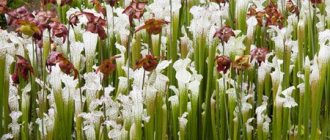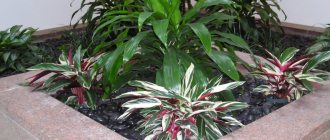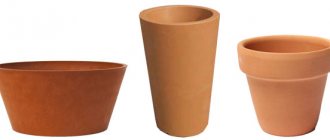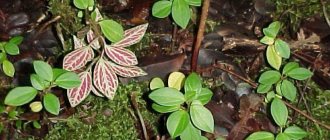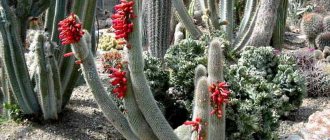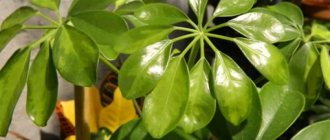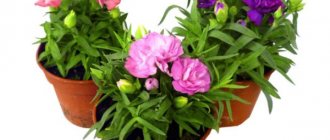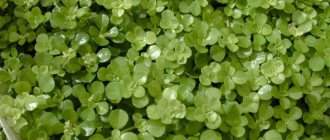Category: Succulents, Care Published 10/13/2018 · Comments: · Reading time: 9 min · Views: 4,913
The low succulent subshrub can easily be mistaken for the flowers of the queen of flower beds, the surprisingly harmoniously arranged rosettes of leaves crowning the crown of each of the few pagons. Aeonium arborescens is therefore called the Irish rose, although many of its relatives are known under another popular name - stone rose.
The plant's homeland is the hilly terrain of the Canary Islands and North-West Africa, mainly in Morocco, where it grows at an altitude of 200 to 1500 m above the sea line. However, the succulent has become widespread in many parts of the planet in the subtropical zone - along the entire western coast of Europe, in the Mediterranean, Australia and New Zealand, as well as in the USA and Mexico.
Types and varieties of aeonium for growing at home
Among all the existing species and varieties of aeonium, many grow normally at home.
Arboreum
Occurs most often. This is a low shrub up to 1 m high. It has an erect trunk covered with brownish-gray bark. The rosette of leaves is loose, up to 20 cm in diameter. The leaves are spade-shaped, with slightly jagged edges, rich green in color. The flowers are yellow and bloom on a long stalk.
Domesticum
A compact plant 15-30 cm high. The trunk is thick, highly branched, the bark is dark brown. The leaves are spatulate, dark green, 2 cm long. The edges are slightly bent downwards.
Decorative (decorum)
The species is up to 20 cm high. The leaves are copper-red, broadly lanceolate, 2.5 cm long, collected in spherical rosettes. But young leaves have a rich green color and change it over time.
Virgin (virgineum)
Almost stemless perennial with a large number of loose leaf rosettes. Thanks to them, the plant looks quite extensive. The leaves are slightly wavy, light green in color, slightly pinkish at the base.
Lindleyi
The species is 15-30 cm tall, with small fleshy leaves collected in baskets on the tops of thin, curved branches. Young leaves are hemispherical, pale green in color. Over time, they become flatter and acquire a yellow tint.
Noble
A short-stemmed succulent with large, heart-shaped, light green leaves. Yellow flowers with a pleasant aroma bloom on a long peduncle.
Burchard (burchardii)
A low hybrid with dark stems on which there are leaf rosettes with a diameter of 10 cm. The leaves are brown-orange, rich green at the base, with pointed tips.
3.Types of aeonium:
3.1.Aeonium arboreum
This species is capable of growing up to 1 - 2 m in height and is a succulent shrub with branched erect stems, on which green teardrop-shaped leaves 5 - 15 cm long are arranged in flat rosettes. The flowers are yellow or purple, up to 2 cm in diameter, collected into pyramidal inflorescences - panicles. The inflorescences emerge from the center of the leaf rosette and after flowering the rosette dies. There are varieties with bright reddish-pink leaves and white flowers and two-color leaf rosettes, painted burgundy on the outside and light green on the inside - this is Aeonium velor (“Velour”) . The edges of the leaf blades often have short cilia.
↑ Up,
3.2.Aeonium schwarzkopf
This species also has another name - “Black Rose”, it belongs to the subspecies of tree-like aeonium. It is distinguished by very dark - almost black flat leaves with a glossy surface, collected in leaf rosettes located at the ends of branched shoots. Only the very center of the rosette can be painted burgundy or green. Of course, this aeonium received its second name precisely because of its leaf rosettes, which are more reminiscent of flowers than leaves. The color of the leaves will be most intense in good light. The yellow flowers that appear in summer add extra appeal to this plant.
↑ Up,
3.3.Aeonium kiwi - Aeonium Kiwi
Perhaps the most colorful type of aeonium - each leaf is painted in 3 colors at once - the center of the leaf blade is light green, followed by a light cream stripe - the layer and edges of the leaves are pink, covered with very small teeth. The flowers are creamy-white, with many yellow, long stamens, collected in vertical branched inflorescences.
↑ Up,
3.4.Aeonium Balsamiferum
A succulent shrub with very thick, twisting, branched shoots. Leaf rosettes are light green in color, reminiscent of roses. The leaves are pointed, thick, fleshy. The flowers are golden-yellow.
↑ Up,
Home care
Aeonium is considered a non-capricious plant. But for normal development it requires certain conditions that are suitable for succulents.
Location and lighting
All types of crops are sun-loving. They need to be provided with bright lighting. Varieties with variegated leaf color lose it when grown in partial shade. Also, a lack of light causes the stems to stretch, bend, and the rosettes become small and unattractive.
It is preferable to place the eonimum on southern or south-eastern windows. But in the summer, during the midday sun, it is better to shade the leaves and protect them from burns. You can take the flowerpot outside, choosing a sunny place. Daylight hours for a succulent should last at least 10-12 hours.
In winter, you can supplement it with phytolamps if it is kept in a warm room. But this measure is ineffective, since the plant does not like artificial lighting. It is better to provide the crop with a full period of rest in winter, during which there will be no need for lighting.
Soil and drainage
Light, loose soil of neutral acidity, which allows moisture to pass through well, is suitable.
You can buy a ready-made mixture for cacti and succulents, or prepare it from:
- leaf soil;
- turf;
- sand.
Take all ingredients in equal proportions. Add some charcoal to the soil. Place a thick layer of drainage at the bottom of the planting pot. It prevents the appearance of root rot. You can use expanded clay and broken shards.
Planting and transplanting
Young specimens are replanted annually. With age, the procedure is performed less frequently - once every 2-3 years. The best time for this is early spring.
Transplant algorithm:
- Prepare a more spacious, deep pot, lay out a high layer of drainage.
- Remove the aeonimum from the old container, being careful not to touch the roots.
- If possible, carefully remove the top layer of the earthen clod.
- Place the plant in a new pot and cover with soil. Bury to the same level as in the old pot.
- Water the bush and place it in a shaded place for a while so that it adapts.
Below is a visual video - instructions for transplanting Aeonium:
Temperature
Aeonium doesn't like heat. During the growing season, a temperature of +16..23 degrees is sufficient for it. If the room is warmer, then you need to provide the succulent with an additional flow of fresh air.
In winter, the plant enters a pronounced dormant period. From October, the temperature is gradually reduced to +8..12 degrees, and the flower is kept in this mode until spring.
Humidity and watering
In spring and summer, watering should be moderate. The soil between them should have time to dry 1/3 deep. In winter, minimal moisture is required. Leaves that have begun to lose turgor will indicate the need for watering.
Aeonium is not critical of air humidity.
It is quite capable of developing normally in a dry room. There is no need to spray it. You can periodically wipe the leaves from dust with a damp cloth. Note! Water the succulent strictly along the edge of the pot. Do not allow water to get into the sockets and the base of the barrel.
Feeding and fertilizers
The need for nutrients in aeonium occurs during the period of active growth. It is recommended to fertilize succulents once every 2 weeks. If you only have universal fertilizer on hand, apply it in half the dosage. Since autumn, the succulent does not need fertilizing.
Bloom
House aeoniums bloom very rarely. The flowers are pyramidal racemes of yellow color. They are highly decorative, but bloom little. In addition, plants with a single stem on which a flower stalk has blossomed usually die after flowering. Therefore, the absence of flowers in aeonium has its advantages.
Trimming
The succulent is fine with formative pruning, but not drastic pruning. They are necessary when the shoots are excessively stretched and the bush loses its decorative properties. In early spring, it is recommended to remove twisted, elongated shoots. They can be used for further reproduction.
Key points in caring for Aeonium succulents at home
These succulent plants do not require much care from you. You just need to adhere to certain conditions in growing these colorful flowers.
Photos of Aeoniums grown at home
What soil is suitable for Aeonium?
Like other succulent plants, Aeoniums need well-draining soil. Use cactus potting mix in combination with perlite for extra drainage at a ratio of about 1 to 1. Other gardeners recommend using sandy soil by mixing cactus potting mix with coarse sand (about a 2 to 1 ratio). A mixture of regular soil, coarse sand, perlite or pumice will also work. If you grow them in pots, repot them every 2-3 years in fresh soil.
Temperature
For succulents during the growing season, the acceptable temperature range is +20…25 °C. However, plants do not like frost and very high temperatures.
Remember! Aeoniums have a growing season from autumn to spring. In summer they remain dormant.
Watering the Aeoniums
Succulents of the genus Aeonium do not require abundant watering. Water them every five to ten days. But in case of prolonged heat, you need to water more often. On the other hand, too much moisture can be a problem for some species.
A good way to check if it's time to water is to check the soil moisture. It is best to water only after the soil in the pot has dried 1/3 of the way. In winter, moisture is limited and carried out only after the leaves begin to lose turgor.
Fertilizer
Feed during the growing season with a balanced, half-strength fertilizer approximately once a month. Do not feed while at rest.
Lighting
Aeoniums require at least six hours of sunlight to fully color their leaves. Provide as much light as possible, but with some shade during hot summers. If you notice that the plant is stretching, this means that the plant is not receiving enough light and is reaching towards the sun. Move the plant to a brighter area.
As a rule, windows facing east, south or west are excellent. If you can't provide enough indoor lighting or have long, dark winters, consider using a grow light.
Aeoniums during dormancy
Succulents go dormant during the summer in very hot, dry weather, especially when left outside in the summer heat. When you see that your Aeoniums are dropping a lot of their lower leaves, the stems will appear bare and unkempt and it may look like the plant is dying, but in reality it is just going through a dormant period. Succulents shed their leaves when they are dormant.
Don't expect too much activity or growth from the Aeoniums during this period. During this time, leave the plant alone and do not stress the plant by cutting stems, repotting or propagating the plant. You can continue to water the plant as usual. Refrain from overwatering and refrain from fertilizing during the dormant season.
Aeonium pruning
After flowering, the rosette of Aeonium dies, releasing a peduncle. It is necessary to trim the flower stalks of the plant along with the dried rosettes.
This video shows the process of pruning faded flower stalks of Eonimum with expert advice
Reproduction methods
You can grow a young plant either generatively (from seeds) or vegetatively.
Seeds
Fill the planting container with a peat-sand mixture. Scatter the seeds over its surface and spray them with a spray bottle. Cover the crops with film and germinate at a temperature of about +20 degrees. Remove the film regularly to ventilate and moisten the soil. After the seedlings have formed 2-3 true leaves, plant them in separate pots with soil for succulents.
Apical cuttings
Cut off the apical shoot with a rosette of leaves at an angle of 45°. Treat the cut area with charcoal. Dry the cuttings for 2-3 days. Plant in sand or a mixture of sand and leaf soil. Deepen by 2 cm. There is no need to cover the top of the cutting with anything. But it is important to provide moderate watering so that the soil always remains slightly moist. The planting must be placed in a room with diffused light.
Leaf
Cuttings are not suitable for all aeoniums, but almost all species can be propagated from leaves. To do this you need to cut several leaves. Dry them for several hours and deepen them into moist soil. Spray its surface regularly to keep it slightly moist. After a while, young rosettes will begin to form above the surface. When they grow a little, they can be transplanted into separate pots.
How does Aeonium reproduce?
Most species of succulents of the genus Aeonium are monocarpic (they die after flowering). If the plant has side shoots, the plant continues to live. Otherwise, the entire plant will die. This is why you need to periodically plant new plants from cuttings. Any Aeonium succulent reproduces in three ways - seed, leaf and cuttings.
Propagation of succulents by seeds
The seed method consists of scattering seeds over the surface of the soil, without immersing them deeply. The container is systematically ventilated, and the planted seed is sprayed. To ensure successful seed germination, create greenhouse conditions by covering the container with glass. The optimal temperature for such a process is considered to be +20 degrees.
Propagation of Aeonium by cuttings
The second method is succulent cuttings. To do this, the stem with the rosette is cut 5 cm lower than the rosette itself. The cut must be processed using crushed activated carbon.
Photos of Aeonium cuttings
In the container where the fresh seedling will grow, be sure to add a sand mixture with leaf soil (ratio - 2 to 1). Afterwards, the Aeonium cuttings are planted and rooted. A prerequisite is soil moisture. The formation of roots can be observed after 15-20 days.
Reproduction by leaves
Leaf propagation involves preparing several leaves. They dry for 2-3 hours, after which they are buried in the ground. It is necessary to systematically spray the surface so that the soil remains slightly moist. After a certain time, young rosettes will begin to form at the top. After they grow up, transplanting into separate pots is allowed.
Seasonal care
Aeonium has clearly defined periods of vegetation and dormancy. In spring and summer, it needs moderate watering, bright lighting, and regular feeding. In winter, the plant rests. It is advisable to arrange cool conditions for him with a temperature of +10..12 degrees. Watering should be sparse (about once a month). If the winter remains warm, then you will have to water the flower more often. It should be taken into account that the aeonium continues to grow, and the lack of winter lighting will cause the shoots to stretch and leaves to drop.
Brief description of cultivation
- Bloom . At home, aeonium almost never blooms.
- Illumination . A large amount of bright sunlight is needed.
- Temperature regime . In summer - no more than 25 degrees, and in winter - from 10 to 12 degrees.
- Watering . During the growing season, watering is carried out 1 or 2 times every 7 days. In winter - once every 30 days.
- Air humidity . Could be anyone.
- Fertilizer . During the growing season, once every 15–20 days, a mineral complex for succulents and cacti is used for this purpose. During the dormant period, the bush is not fed.
- Rest period . In winter time.
- Transplant . While the bush is young - once a year, adult plants - once every 2 or 3 years.
- Reproduction . By cuttings and seed method.
- Diseases . Rotten.
- Pests . Aphids, mealybugs, mites and scale insects.
Aeonium - types, varieties, propagation, care, the secret of a successful culture - master Georgy Aristov
Care errors and their elimination
The table contains useful information for gardeners about problems when growing Aeonium and how to eliminate them:
| Problem | Causes | Solution |
| Exposure of the lower part of the stem, shrinkage of leaves | Cramped pot, lack of moisture and light | Transplant the plant into a larger container, place it in a bright place and increase the number of waterings |
| Dying of leaves, turning stems and leaves black | Excess moisture, keeping in a cold room | Reduce watering, regulate temperature conditions |
| Appearance of red color on green leaves | Sunburn | Shade the bush from the midday sun |
| Loose rosette, plant tilted to one side | Lack of light | Move the flowerpot to a well-lit place |
Diseases and pests, control methods
Aeonium, when the soil is excessively waterlogged and overcooled, can be affected by gray or root rot. For treatment, it is necessary to remove the plant from the pot and remove all affected parts. Treat with a fungicide and replant the succulent in fresh soil. To prevent fungal infections, it is necessary to control the amount of watering, avoid over-moistening the soil and not overcool the plant.
Of the pests, aeonium is most often attacked by mealybugs. They usually settle between the leaves of the rosette, spoil the appearance and slow down the growth of the succulent. The plant is very sensitive to the effects of chemicals. Therefore, it is better to start fighting parasites with safer methods. Wipe the leaves with soapy water or alcohol. Remove adult insects by hand.
Severe infestation requires the use of insecticides:
- Karbofos,
- Aktara,
- Fitoverm;
- Decis;
- Aktellik and others.
Aeonium in the home: beneficial properties
This plant is not poisonous and does not emit harmful substances. Therefore, it can be safely placed in a children’s room or bedroom.
According to Feng Shui, aeonium in the house symbolizes long life and prosperity. Therefore, it not only decorates the interior, but also increases the internal strength of the owner, helps him develop, attracts finances, health, and love.
Aeonium also has medicinal properties. Its juice is used externally for herpes, skin inflammation, and abscesses. It contains antiseptic substances that kill pathogenic bacteria. The juice is included in remedies for abrasions, burns, and itching.
Aeonium is an exotic succulent whose decorative appearance was created by nature itself. Many plant species have adapted well to indoor conditions. But in order to maintain its decorative properties, proper care is necessary.
More useful recommendations about growing and caring for Aeonium at home can be found after watching the video:

